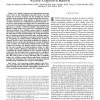Free Online Productivity Tools
i2Speak
i2Symbol
i2OCR
iTex2Img
iWeb2Print
iWeb2Shot
i2Type
iPdf2Split
iPdf2Merge
i2Bopomofo
i2Arabic
i2Style
i2Image
i2PDF
iLatex2Rtf
Sci2ools
140
click to vote
TSP
2012
2012
Sensing and Probing Cardinalities for Active Cognitive Radios
—In a cognitive radio network, opportunistic spectrum access (OSA) to the underutilized spectrum involves not only sensing the spectrum occupancy but also probing the channel quality in order to identify an idle and good channel for data transmission—particularly if a large number of channels is open for secondary spectrum reuse. Although such a joint mechanism, referred to as active sensing, may improve the OSA performance due to diversity, it inevitably incurs additional energy consumption. In this paper, we consider a wideband cognitive radio network with limited available frame energy and treat a fundamental energy allocation problem: how available energy should be optimally allocated for sensing, probing, and data transmission to maximize the achievable average OSA throughput. By casting this problem into the multiarmed bandit framework under probably approximately correct (PAC) learning, we put forth a proactive strategy for determining the optimal sensing cardinality (the nu...
Artificial Intelligence | Elimination Algorithm | Secondary Spectrum | Spectrum Occupancy | TSP 2012 |
Related Content
| Added | 25 Apr 2012 |
| Updated | 25 Apr 2012 |
| Type | Journal |
| Year | 2012 |
| Where | TSP |
| Authors | Thang Van Nguyen, Hyundong Shin, Tony Q. S. Quek, Moe Z. Win |
Comments (0)

